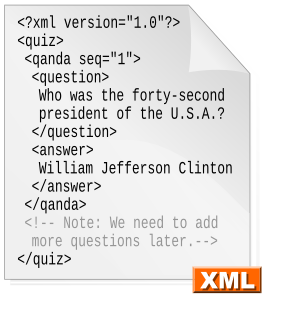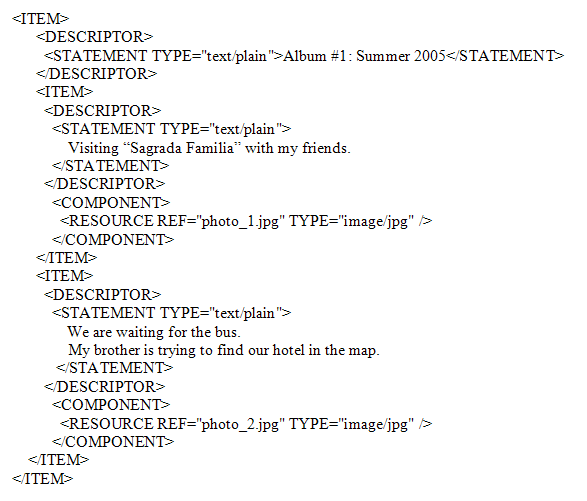
The Dublin Core Schema is a small set of vocabulary terms that can be used to describe digital resources, as well as physical resources such as books or CDs, and objects like artworks. The full set of Dublin Core metadata terms can be found on the Dublin Core Metadata Initiative (DCMI) website. The original set of 15 classic metadata terms, known as the Dublin Core Metadata Element Set (DCMES), is endorsed in the following standards documents:

The Moving Picture Experts Group (MPEG) is a working group of authorities that was formed by ISO and IEC to set standards for audio and video compression and transmission. It was established in 1988 by the initiative of Hiroshi Yasuda and Leonardo Chiariglione, group Chair since its inception. The first MPEG meeting was in May 1988 in Ottawa, Canada. As of late 2005, MPEG has grown to include approximately 350 members per meeting from various industries, universities, and research institutions. MPEG's official designation is ISO/IEC JTC 1/SC 29/WG 11 – Coding of moving pictures and audio.
The Semantic Web is an extension of the World Wide Web through standards set by the World Wide Web Consortium (W3C). The goal of the Semantic Web is to make Internet data machine-readable. To enable the encoding of semantics with the data, technologies such as Resource Description Framework (RDF) and Web Ontology Language (OWL) are used. These technologies are used to formally represent metadata. For example, ontology can describe concepts, relationships between entities, and categories of things. These embedded semantics offer significant advantages such as reasoning over data and operating with heterogeneous data sources.

Extensible Markup Language (XML) is a markup language that defines a set of rules for encoding documents in a format that is both human-readable and machine-readable. The World Wide Web Consortium's XML 1.0 Specification of 1998 and several other related specifications—all of them free open standards—define XML.
MPEG-7 is a multimedia content description standard. It was standardized in ISO/IEC 15938. This description will be associated with the content itself, to allow fast and efficient searching for material that is of interest to the user. MPEG-7 is formally called Multimedia Content Description Interface. Thus, it is not a standard which deals with the actual encoding of moving pictures and audio, like MPEG-1, MPEG-2 and MPEG-4. It uses XML to store metadata, and can be attached to timecode in order to tag particular events, or synchronise lyrics to a song, for example.
The MPEG-21 standard, from the Moving Picture Experts Group, aims at defining an open framework for multimedia applications. MPEG-21 is ratified in the standards ISO/IEC 21000 - Multimedia framework (MPEG-21).
MARCstandards are a set of digital formats for the description of items catalogued by libraries, such as books. Working with the Library of Congress, American computer scientist Henriette Avram developed MARC in the 1960s to create records that could be read by computers and shared among libraries. By 1971, MARC formats had become the US national standard for dissemination of bibliographic data. Two years later, they became the international standard. There are several versions of MARC in use around the world, the most predominant being MARC 21, created in 1999 as a result of the harmonization of U.S. and Canadian MARC formats, and UNIMARC. UNIMARC is maintained by the Permanent UNIMARC Committee of the International Federation of Library Associations and Institutions (IFLA), and is widely used in Europe. The MARC 21 family of standards now includes formats for authority records, holdings records, classification schedules, and community information, in addition to the format for bibliographic records.
Digital storage media command and control (DSM-CC) is a toolkit for developing control channels associated with MPEG-1 and MPEG-2 streams. It is defined in part 6 of the MPEG-2 standard and uses a client/server model connected via an underlying network.
The PBCore metadata standard was created by the public broadcasting community in the United States of America for use by public broadcasters and related communities that manage audiovisual assets, including libraries, archives, independent producers, etc. PBCore is organized as a set of specified fields that can be used in database applications, and it can be used as a data model for media cataloging and asset management systems. As an XML schema, PBCore enables data exchange between media collections, systems and organizations.
XrML is the eXtensible Rights Markup Language which has also been standardized as the Rights Expression Language (REL) for MPEG-21. XrML is owned by ContentGuard.
A metadata registry is a central location in an organization where metadata definitions are stored and maintained in a controlled method.
MPEG-4 Part 11Scene description and application engine was published as ISO/IEC 14496-11 in 2005. MPEG-4 Part 11 is also known as BIFS, XMT, MPEG-J. It defines:

MPEG-4 Part 14 or MP4 is a digital multimedia container format most commonly used to store video and audio, but it can also be used to store other data such as subtitles and still images. Like most modern container formats, it allows streaming over the Internet. The only official filename extension for MPEG-4 Part 14 files is .mp4. MPEG-4 Part 14 is a standard specified as a part of MPEG-4.
BiM is an international standard defining a generic binary format for encoding XML documents.
The Open Packaging Conventions (OPC) is a container-file technology initially created by Microsoft to store a combination of XML and non-XML files that together form a single entity such as an Open XML Paper Specification (OpenXPS) document. OPC-based file formats combine the advantages of leaving the independent file entities embedded in the document intact and resulting in much smaller files compared to normal use of XML.

Metadata is "data that provides information about other data". In other words, it is "data about data." Many distinct types of metadata exist, including descriptive metadata, structural metadata, administrative metadata, reference metadata and statistical metadata.
A metadata standard is a requirement which is intended to establish a common understanding of the meaning or semantics of the data, to ensure correct and proper use and interpretation of the data by its owners and users. To achieve this common understanding, a number of characteristics, or attributes of the data have to be defined, also known as metadata.
The Office Open XML file formats are a set of file formats that can be used to represent electronic office documents. There are formats for word processing documents, spreadsheets and presentations as well as specific formats for material such as mathematical formulae, graphics, bibliographies etc.
ISO/IEC 19788Information technology – Learning, education and training – Metadata for learning resources is a multi-part standard prepared by subcommittee SC36 of the Joint Technical Committee ISO/IEC JTC1, Information Technology for Learning, Education and Training. This committee was created to deal with the consequences of substantial overlap in areas of standardization done at the International Organization for Standardization (ISO) and the International Electrotechnical Commission.







